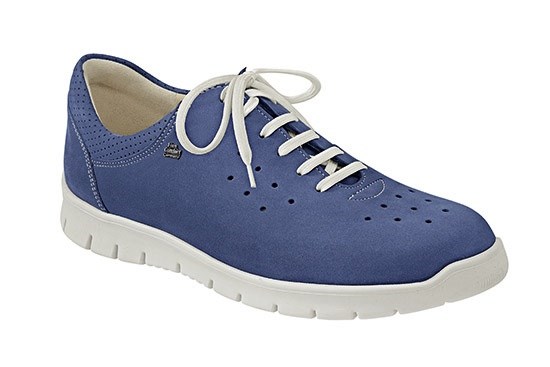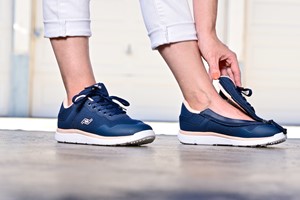I’m wearing healthy shoes for my feet… aren’t I?
So, you believe you are buying healthy footwear, however - your feet still hurt? But, are you REALLY buying healthy footwear and importantly – are you wearing the correct size andshape for your feet.

Our feet were designed to walk on soft, cushioned surfaces in nature – unlike in our modern world of concrete!
As we get older, or if we have a chronic health condition, our footprint in the sand will change. Just like every other part of our body, our feet age too and begin to show signs of wear. Arches may lower, toes may claw, bunions can appear and also fatty pads become thinner. All of this can result in foot pain both from the joint deformity but also from the shoe fitting. Why don’t your shoes fit you any more?
- If you are a woman wearing a ‘court’ style shoe – no doubt your toes are touching the end! So your shoes are, in fact, too short.
- Do you have a bunion? If your shoes are too narrow, but also too shallow – there is not enough room for your bunion joint deformity, and your skin will become red and irritated.
- Do the balls of your feet hurt? Then your shoes perhaps are not cushioned enough inside and outside.
- Have your arches collapsed? Looking down – are your feet ‘rolling in’?
- Are your toes clawing up and rubbing on the tops of your shoes? Do you have corns? On the top of your feet, corns are only caused by pressure from shoe uppers.
Having foot pain is serious, it can stop you enjoying the basics of life such as taking the dog for a nice long walk, or spending time shopping, or walking with friends for fun and exercise. Poor foot posture can also affect ankles, knees and backs. If you have foot pain, it is time to look upon your footwear as not only a fashion statement, they must be comfortable and supportive. And healthy footwear is not necessarily unfashionable anymore! A few tips to look for when you buy your shoes are:
Does the shoe have a removable insole? If so, you can fit in an arch support or an orthotic device if prescribed for you.
- If you have a bunion, check the the upper of the shoe is not too tight over this, and also no seams over the bunion area. An all leather upper is preferable, as leather will stretch gently over the bunion area.
- Buy shoes with cushioning soles to absorb the impact on your joints. Many of these materials are light also and still hard wearing.
- Make sure that you have wiggle room! You should not be touching the end of the shoe with your longest toe – and remember, this is not always your 1st toe, many people have longer 2nd or 3rd
What chronic health conditions can affect my feet?
Foot conditions are often associated with other long term health conditions and some of these are:-
Diabetes. People with diabetes are at a greater risk of foot ulceration* and therefore need to be very careful with their foot health and shoe fitting. The reason for the increased risk is neuropathy (nerve damage) and reduced circulation, causing loss of sensation and slower healing from a minor skin break or injury, such as a blister or standing on a sharp object.
Arthritis. The two most common forms of arthritis, osteo and rheumatoid, affect the feet differently but both cause pain and joint deformity. Osteoarthritis in the feet often responds well to a thicker, firmer sole shoe such as a stable rocker sole. Rheumatoid arthritis makes the feet extremely sensitive to pressure and weight, so a lighter, more flexible shoe often helps.
Heart disease. Fluid accumulation in the body can be a sign of worsening heart disease, due to reduced blood flow back out of the heart, causing the blood and fluid returning to back up. You will notice swelling, particularly later in the day, in your lower legs and ankles. Make sure the shoes have an easy, long opening to get the feet in and that the shoes are not too high around the ankles.
So remember..
It isn’t the mountain ahead that wears you out, it’s the grain of sand in your shoe.. (Robert W. Service)
With the right pair of healthy, well fitting shoes the world awaits you!
More information on diabetes and foot complications can be found at:
https://www.diabetes.org.uk/Guide-to-diabetes/Complications/Feet/
Compiled by Lisa Preston
ShoeMed
5, The Minories, Henley Street
Stratford upon Avon
WARWICKSHIRE CV37 6NF
Blog home >
Recent Posts
-
Manikins Get New Slippers
Health & Social Care students at Strode College in Somerset have kitted out the lifelike manikins on their simulation …
read more
-
Friendly Shoes join the HFG-a warm welcome to you.
Introducing Friendly Shoes, the UK’s first fully adaptive footwear brand
Designed by an occupational therapist, …
read more
-
Cosyfeet achieves platinum in US and UK
Cosyfeet Achieves Platinum in US and UK
Cosyfeet, the Somerset-based retailer of premium footwear for people with …
read more




